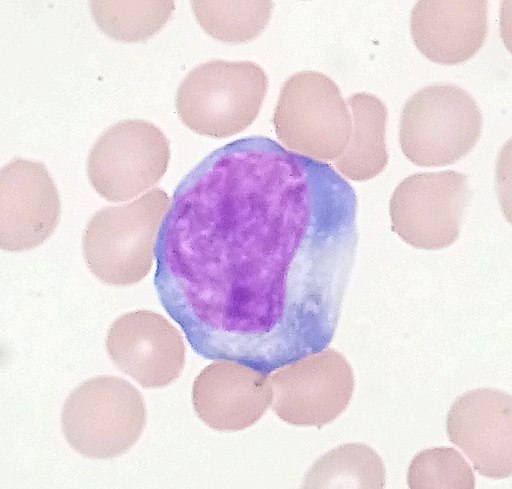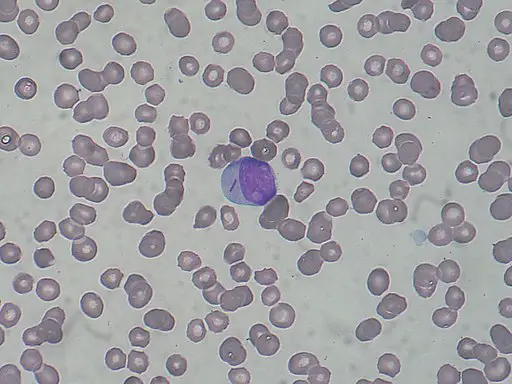Lymphoblasts
Definition, Vs Lymphocytes & Lymphoblastoid Cell Lines
Found in the red bone marrow, lymphoblasts are medium-sized to relatively large cells (ranging from 10 to 10um) that give rise to lymphocytes.
Like other progenitor cells, a lymphoblast is an immature cell and therefore does not perform a specific function in the body other than differentiating to produce more specialized/functional cells.
As they are produced along the lymphoid stem cell lineage, lymphoblasts normally develop through a series of events to produce healthy lymphocytes in order to fight infections.
Under certain conditions (e.g. in lymphoblastic leukemia), they may fail to mature and consequently affect the normal production of other blood cells, especially when they are rapidly produced.
Some of the signaling molecules involved in the production of lymphoblasts (from the lymphoid stem cells) include:
IL-3 (interleukin 3)
IL-5 (interleukin 5)
AG-CSF (Agranulocytic colony-stimulating factor)
Difference between Lymphoblasts and Lymphocytes
While lymphoblasts gives rise to lymphocytes, there are a number of differences between the two types of cells.
These include:
Level of Differentiation
One of the main differences between lymphoblasts and lymphocytes is with regards to their level of differentiation. As mentioned, a lymphoblast cell is a progenitor that undergoes differentiation to produce cells that ultimately give rise to lymphocytes. As such, it's less differentiated compared to the cells it produces.
Classified as unipotent progenitors, lymphoblasts can only give rise to one cell type that differentiates further depending on given signaling molecules. Compared to the lymphoblast, a lymphocyte is more differentiated.
Also, following differentiation of the prolymphocyte, the lymphocytes that are produced can also develop/mature to produce more functional/specialized cells.
Unlike lymphoblasts, some of the lymphocytes migrate to the thymus, and develop to become T cells, while those that remain in the bone marrow mature to become B cells. At this stage, these cells are more differentiated compared to lymphoblasts. They can also undergo differentiation to produce more specialized cells.
For instance, in the presence of given antigens, B cells develop to produce antibody-producing cells (plasma cells) while T cells produce cytotoxic T cells or Helper T cells in the thymus.
Location
In a healthy individual, lymphoblasts, like other progenitors, are found in the red bone marrow. Here, when they are stimulated by given factors, they proliferate and differentiate to produce lymphocyte precursors.
While lymphocytes are produced by progenitors residing in the bone marrow, they are not restricted to this region of the body. Rather, they can migrate to other parts of the body like the thymus, spleen, or enter circulation (blood).
Unlike lymphocytes, lymphoblasts are progenitors whose function is to differentiate and give rise to lymphocyte precursors. For this reason, they do not need to leave the bone marrow. Lymphocytes, on the other hand, are more differentiated and can readily mature to produce specialized cells.
For this reason, they are appropriately located in parts of the body where they can perform their respective functions whenever need be.
Morphology
Lymphoblasts and lymphocytes can also be differentiated based on their general morphology and structure. Here, however, it's worth noting that lymphoblasts have been shown to exhibit variable morphology. While some may appear to be enlarged with fine nuclear chromatin, others are small or medium-sized with condensed chromatin.
In cases where the chromatin is condensed, studies have shown the cytoplasm to be generally scant. The nucleus, which may contain one or two nucleoli, has a well-developed nuclear membrane which makes it possible to identify the size and location of the nucleus.
Like a lymphoblast, lymphocytes are also characterized by a large (coarse) nucleus with little cytoplasm. Despite having little cytoplasm, lymphocytes contain a number of important organelles, similar to other eukaryotic cells, including the Golgi body, the Endoplasmic Reticulum, ribosome, mitochondria as well as vacuoles.
Some of the other differences between lymphocytes and lymphoblasts (morphologically) include:
· Lymphocytes have more cytoplasm than lymphoblasts. The nucleus-cytoplasmic ratio in lymphoblast is about 4:1 which this ratio in lymphocytes is about 2:1
· Unlike lymphoblasts, mature lymphocytes do not have nucleoli
Precursors
One of the other differences between lymphocytes and lymphoblasts is with regards to their precursors. While the two types of cells occur within the same lineage, they have different precursors.
Located in the red bone marrow, the lymphoblast is produced through the differentiation of lymphoid stem cells under the influence of IL-3, IL-5, and AG-CSF. Lymphocytes, on the other hand, are produced following the differentiation of prolymphocytes which themselves originate from the lymphoblast.
In general, this lineage may be presented as follows:
Lymphoblastoid cell lines
Lymphoblastoid cell lines refer to a type of cells that are commonly used as a substitute for blood lymphocytes in the body. For a long time, they have been produced by infecting B cells with the virus, Epstein-Barr virus.
In vitro, these cells are important given that they can be used to study various characteristics/properties of the cells as well as their responses to stimuli.
Following the infection of B cells with the virus, lymphoblastoid cell lines are said to be immortalized as they can continue growing and giving rise to new cells to be used for studies. Here, not all B cells are immortalized. Rather, the virus only immortalizes resting B cells so that they are transformed to produce actively proliferating cells.
In the infected cells, the virus is primarily aimed at establishing a latent infection. Therefore, instead of actively replicating resulting in subsequent damage to the cells (B cells), the virus remains inactive/dormant within the cells.
While the virus remains inactive, it continues to produce a few proteins (membrane proteins (e.g. LMP1), untranslated nuclear RNA, etc.).
* The Epstein-Barr virus is one of the most common viruses and infects more than 90 percent of human beings.
* Lymphoblastoid cell lines can be maintained in culture for a long period of time which allows researchers more than enough time to continue studying them.
Apart from an extended life span, one of the main characteristics of lymphoblastoid cell lines is the fact that they, like B lymphocytes, produce immunoglobulin. Located on the surface of lymphocytes and Lymphoblastoid cell lines, immunoglobulin are B cell receptors that allow the cells to identify and bind to given antigens.
In addition, they contain different types of organelles associated with peripheral lymphocytes.
As well as being immortalized, perhaps one of the biggest advantages of lymphoblastoid cell lines is that they only exhibit very low rates of somatic mutation during culture. This is a big advantage for biological studies as they serve as the ideal storage for genetic material under investigation.
* Compared to other viruses (e.g. the human papillomavirus and the simian virus 40), the Epstein Barr virus (EBV) is routinely used because it transforms (immortalizes) B lymphocytes without causing significant genetic or phenotypic aberrations.
Moreover, the virus has been shown to easily establish the cells and maintain them during culture.
* Because they last longer, lymphoblastoid cell lines serve as unlimited sources of various research biomolecules (proteins, RNA, and DNA, etc.)
Lymphoblast Vs Myeloblast
Although they are rarely seen in peripheral blood and may prove challenging to differentiate from the blasts of the other hematopoietic cell lines, myeloblasts are immature blood cells found in the granulocytic cell line in the myeloid lineage. As the "youngest" cell in the myeloid lineage, the myeloblast is more differentiated compared to its precursors and is generally classified as a unipotent progenitor capable of giving rise to one cell type.
Like a good number of other cells, the myeloblast is a medium-sized cell ranging from 12 to 20 microns. It's characterized by a large, ovoid nucleus that takes up about two-thirds of the total cell volume.
Like the lymphoblast, the nucleus of the myeloblast contains several nucleoli. Because of the enlarged nucleus, the cell also contains little cytoplasm and few organelles.
While myeloblasts and lymphoblasts originate from hematocytoblasts and are involved in the production of blood cells, there are several differences between the two.
These include:
Give rise to different types of cells - One of the main differences between lymphoblast and myeloblast is that they give rise to different types of blood cells following differentiation.
Whereas the lymphoblast gives rise to lymphocytes (B and T lymphocytes) following differentiation, the myeloblast produces granulocytes characterized by the presence of granules in their cytoplasm (basophils, eosinophil, and neutrophils).
Size - While they are both relatively large cells, the myeloblast is slightly larger than the lymphoblast. While the average size of a lymphoblast is about 15 microns, that of an average myeloblast is about 20 um
Nucleoli - Both lymphoblast and myeloblast contain nucleoli. However, in general, the myeloblast contains more nucleoli compared to the lymphoblast.
Nucleus - Compared to the shape of the nucleus in the lymphoblast which tends to be more spherical/round, the shape of a myeloblast nucleus may vary.
Similarities between Myeloblast and Lymphoblast
The myeloblast and lymphoblast also have similarities that include:
Both involved in hematopoiesis - As mentioned, both myeloblast and lymphoblast originate from the hematocytoblast (through the myeloid and lymphoblast progenitors respectively). Through their differentiation, they give rise to different types of blood cells involved in the immune system.
The two types of cells, therefore, play a central role in hematopoiesis
Both progenitor cells - Unlike the specialized cells that are ultimately produced through the myeloid and lymphoid lineages (lymphocytes and granulocytes etc.), myeloblast and lymphoblast are both progenitor cells.
They can undergo proliferation and differentiation to produce more specialized/functional cells. However, unlike stem cells, the two types of cells are not capable of prolonged self-renewal.
Located in the bone marrow - While some progenitors can be found in circulation, especially in the event of unregulated proliferation, lymphoblast and myeloblast are both found in the bone marrow under normal circumstances.
Here, they are able to give rise to more specialized cells that ultimately leave the bone marrow and enter circulation or migrate to other tissues.
Return from Lymphoblasts to MicroscopeMaster home
References
Daniel Osorio, Xue Yu, Peng Yu, Erchin Serpedin & James J. Cai. (2019). Single-cell RNA sequencing of a European and an African lymphoblastoid cell line.
Elliott D. SoRelle et al. (2020). Single-cell characterization of transcriptomic heterogeneity in lymphoblastoid cell lines.
Matthew W. Klinker et al. (2014). Human B cell-derived lymphoblastoid cell lines constitutively produce Fas ligand and secrete MHCII+FasL+ killer exosomes.
Teresan Frisan, Victor Levitsky, and Maria Masucci. (2001). Generation of Lymphoblastoid Cell Lines (LCLs).
Links
https://www.sciencedirect.com/topics/biochemistry-genetics-and-molecular-biology/myeloblast
Find out how to advertise on MicroscopeMaster!







